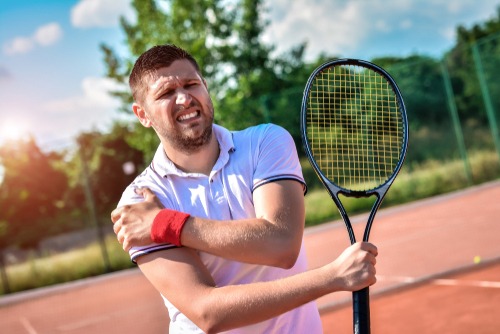Shoulder Instability
 Shoulder instability happens when the shoulder joint’s lining, labrum, or ligaments become torn, stretched, or detached. This allows the humeral head or the ball of the shoulder joint to move partially or completely out of the socket. Individuals with this type of instability feel pain when the shoulder is not in its place.
Shoulder instability happens when the shoulder joint’s lining, labrum, or ligaments become torn, stretched, or detached. This allows the humeral head or the ball of the shoulder joint to move partially or completely out of the socket. Individuals with this type of instability feel pain when the shoulder is not in its place.
Thomas & Bigler Knee & Shoulder Institute, led by board certified orthopedic surgeons Dr. Steven C. Thomas and Dr. Gregory T. Bigler, provides orthopedic surgery to patients in Las Vegas, Nevada as well as greater Pahrump, Bullhead City, Lake Havasu, and Mesquite, NV.
Shoulder Instability Types
- Shoulder Subluxation and Dislocation
The humeral head can be dislocated or subluxed with significant trauma to a normal joint. Shoulder subluxation takes place when the humerus quickly slides in and out (partially) of place. Shoulder dislocation takes place when the humerus comes out of the glenoid. It may need to be pushed back in place with medical assistance or may fall back in with time on its own.
- Labral Tear
Shoulder instability happens when the labrum is peeled or torn off the glenoid. It can happen following a shoulder dislocation or shoulder trauma because of repetitive motion.
- Genetic Condition
Some people are born with loose shoulder ligaments because of spacious or loose capsule. Instability, for these people, can happen without any trauma or after a relatively minor injury. Some people may also have a genetic condition that loosens the joints and predisposes them to develop weakness or instability in the shoulder.
When is Surgery Needed?
The shoulder may be unstable or loose despite a full course of physical therapy in which shoulder strength or motion are restored. Treatment options may consist of surgery or activity modification. Activity modification is mainly recommended for patients that experience instability while performing certain activities. In such patients, avoiding the activity can eliminate the episode of dislocation or subluxation.
Surgical treatment is considered in patients that are not willing to give up sports or activities provoking the episodes. The surgery will involve a physical examination of the shoulder under anesthesia to assess the direction and extent of instability. Generally, an arthroscope is used for inspecting the inside of the shoulder joint for evaluating the joint and cartilage.
The arthroscope will allow direct assessment of the condition of the rotator cuff tendons and labrum. Arthroscopic techniques may be used for stabilizing the shoulder in a limited number of patients that have mild laxity or looseness in the shoulder.
Open Surgery
Open surgery is often required for correcting severe instability. An incision will be made on the shoulder and the muscles will be moved for gaining access to the join capsule, labrum, and ligaments. The structures are then reattached, repaired, or tightened depending on the injury.
The repair can be performed with simple sutures or sutures that are attached to metal or plastic anchors. The anchors are inserted in the bone for tightening or reattaching the ligaments. The anchors remain in the bone permanently.
Board certified orthopedic surgeons Dr. Thomas and Dr. Bigler receive patients from Las Vegas, Nevada as well as greater Pahrump, Bullhead City, Lake Havasu, and Mesquite, NV for dependable and proven orthopedic surgery procedures.
Contact Board Certified Surgeons Dr. Bigler or Dr. Thomas at the Knee and Shoulder Institute in Las Vegas, NV to Schedule an Appointment:
If you would like to schedule an appointment or learn more about the Knee and Shoulder Institute procedures & treatments performed by Las Vegas, Nevada board-certified surgeons Steven C. Thomas, MD and Gregory T. Bigler, MD. Contact the office today click here.
Serving patients from and around greater Las Vegas, Lake Havasu, Bullhead City, Mesquite, Pahrump, Nevada
